Waves, Sound and Light Questions and Answers Grade 10
Share via Whatsapp Join our WhatsApp Group Join our Telegram GroupQuestions
Question 1: Multiple choice
Choose the correct answer. Write down only the letter of the answer you select.
1.1 What is the angle between the electric and magnetic fields in an electromagnetic wave?
- 0°
- 90°
- 180°
- 360° (3)
1.2 What is the period of a wave with a frequency of 5 Hz?
- 0,2 s
- 5,0 s
- 2,0 s
- 20,0 s (3)
1.3 Two transverse pulses meet and cancel out through a process called:
- diffraction.
- reflection.
- constructive interference.
- destructive interference. (3)
1.4 In order to calculate the speed of a wave, which formula would you use?
- wavelength ÷ frequency
- frequency ÷ wavelength
- wavelength ÷ period
- frequency × period (3)
1.5 The speed of a water wave is 4 m.s-1. If the frequency is 8 Hz, what is the wavelength?
- 32 m
- 2 m
- 12 m
- 0,5 m (3)
1.6 A vibrating hacksaw blade completes 40 oscillations (complete vibrations) in 5 s. What is its period?
- 8 s
- 0,125 s
- 0,2 s
- 0,025 s (3)
1.7 The speed at which water molecules are moving in a wave in a ripple tank:
- is greatest in a trough.
- is greatest in a crest.
- is smallest in the rest position.
- is greatest in the rest position. (3)
1.8 Sound travels fastest through a:
- solid.
- liquid.
- gas.
- vacuum. (3)
1.9 The sketch shows a rope with two pulses of equal amplitude approaching each other. When the two pulses pass through point X, what is the maximum ampli- tude of the pulse?
- D
- 0
- 2 D
- ½ D (3)
1.10 Which diagram below has both the wavelength () and the amplitude (A) la- belled correctly?



 (3)
(3)
1.11 Sound is:
- a series of moving compressions and rarefactions.
- an example of a transverse wave.
- able to travel through a vacuum.
- an example of a longitudinal wave.
Which of the above statements about sound is/are correct?
- 1, 2 and 3
- 1 and 2 only
- 1 and 3 only
- 1 and 4 (3)
1.12 The wavelength of a particular form of electromagnetic radiation in a vacuum is 10–12 m. The wavelength of a form of electromagnetic radiation of twice the frequency is:
- 2,5 × 10–13 m.
- 10–6 m.
- 5 × 10–13 m.
- 2 × 10–12 m. (3)
1.13 The energy of a photon of electromagnetic energy can be calculated using the equation:
- E = hf.
- E = h ÷ f.
- E = λ ÷ hc.
- E = hλ ÷ c. (3) [39]
Question 2: True/false
Indicate whether the following statements are true or false. If the statement is false, write down the correct statement.
2.1 In a longitudinal wave, each particle in the medium is travelling fastest as it passes through the rest position. (2)
2.2 In a transverse wave, a pulse length is equal to a wavelength. (2)
2.3 Wavelength is the maximum displacement from the position of rest. (2)
2.4 An increase in frequency of a sound wave and a simultaneous increase in amplitude will cause a note that is louder and has a lower pitch. (2)
2.5 The energy of electromagnetic radiation is directly proportional to the wavelength of the radiation. (2) [10]
Question 3: One-word answers
Provide one word or term for each of the following descriptions. Write only the word or term next to the question number.
3.1 The colour of visible light that has the shortest wavelength, highest frequency and greatest energy. (1)
3.2 A region in a longitudinal wave where the particles of the medium have been pulled far apart. (1)
3.3 The type of electromagnetic radiation that is responsible for us feeling the heat from the sun. (1)
3.4 The distance between two consecutive points in a longitudinal wave that are in phase. (1)
3.5 A quantum of visible light. (1) [5]
Question 4: Matching pairs
Choose an item from column B that matches the description in column A. Write only the letter of your choice (A–J) next to the question number.
Column A | Column B |
4.1 released during nuclear reactions | A S |
4.2 a unit for frequency | B electric field |
4.3 a charged particle experiences a force | C gamma rays |
4.4 distance moved per second | D speed |
4.5 a quantum of visible light | E s–1 |
F photon | |
G magnetic field | |
H microwaves | |
I proton | |
J frequency |
[5]
Question 5: Long questions
The sketch below shows a pendulum consisting of a weight attached to the end of a length of string. The pendulum was set in motion by pulling the weight to position A and releasing it.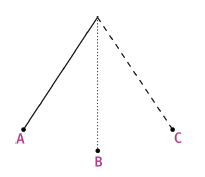
Explain the meaning of each of the following terms, making use of the positions shown in the sketch where appropriate.
5.1 one oscillation (or complete vibration) (2)
5.2 the rest position (or equilibrium position) (2)
5.3 frequency (2)
5.4 amplitude (2)
5.5 period (2) 5 × 2 = [10]
Question 6: Long questions
The sketch below shows a transverse wave in a medium.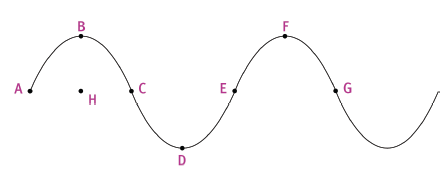
Use the letters supplied in the sketch to indicate the following:
6.1 the rest position (position of equilibrium) (2)
6.2 two points that are in phase (2)
6.3 a crest 2)
6.4 amplitude (2)
6.5 two points completely out of phase (2)
6.6 wavelength (2) 6 × 2 = [12]
Question 7: Long questions
Refer again to the illustration in question 6. Ten wavelengths pass point B in 2 seconds. The distance between points B and F is 300 mm. Calculate (in SI units):
7.1 the frequency (2)
7.2 the period (3)
7.3 the speed of the waves. (4) [9]
Question 8: Long questions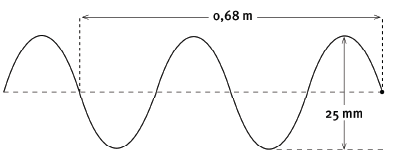
Each particle in the wave shown above completes one vibration (oscillation) in 0,4 s.
8.1 How long will it take eight wavelengths to pass a specific point in the medium? (2)
8.2 What is the amplitude of this wave? (2)
8.3 What is the period of this wave? (2)
8.4 What is the wavelength of this wave? (2)
8.5 Calculate the frequency of the wave. (3)
8.6 Calculate the speed of the wave. (4) [15]
Question 9: Long questions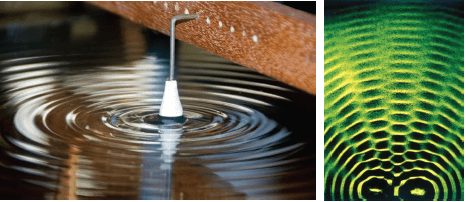
Two beads are attached to the vibrator of a ripple tank and are positioned so that they dip into the water, as shown in the photo above. The resultant pattern is shown in the second photograph.
9.1 What is the phenomenon in the tank called? (2)
9.2 What do the fan-shaped lines in the second photo represent? (2)
9.3 How are these lines formed? (2) [6]
Question 10: Long questions
10.1 What type of wave is a sound wave that reaches your ear? (2)
10.2 Explain briefly how you would use a slinky spring to demonstrate this type of wave to a friend. (4)
10.3 What is meant by the ‘wavelength’ of this type of wave? (2) [8]
Question 11: Long questions
A typical sound wave associated with human speech has a frequency of 500 Hz, while the frequency of yellow light is about 5 × 1014 Hz. Assuming that sound travels at 340 m.s-1 and light at 3 × 108 m.s–1:
11.1 Calculate the wavelength of the sound wave. (4)
11.2 Calculate the wavelength of yellow light. (3)
11.3 Express the wavelength of yellow light in nanometres. (1) [8]
Question 12: Long questions
2.1 Describe an experiment or demonstration that shows that sound cannot travel in a vacuum. (5)
12.2 Why is the moon sometimes referred to as ‘the silent planet’? (2)
12.3 The speed of sound in air is 340 m.s–1. Calculate the wavelength of the sound produced by a tuning fork of frequency 156 Hz. (4)
12.4 Calculate the period of this sound wave. (3)
12.5 What is the sound called that has a frequency higher than the human ear can hear? (1)
12.6 Describe one use for this type of high-frequency sound wave. (2) [17]
Question 13: Long questions
Vibrations of frequency 2,0 Hz are produced by a generator attached to a spring. These vibrations are at 90° to the spring. The waves that it produces have a wavelength of 0,45 m.
13.1 What type of wave is passing along the spring? (1)
13.2 How many complete wavelengths pass a point in the spring in 3 seconds? (2)
13.3 What is the speed of the waves along the spring? (4)
13.4 Calculate the time taken for three complete wavelengths to pass a point in the spring. (5)
13.5 What is the wavelength of the waves along the spring if their frequency is in- creased to 6,0 Hz, without changing the tension (stretch) of the spring? (4) [16]
Question 14: Long questions
Sunlight is a form of electromagnetic radiation.
14.1 What is an ‘electromagnetic wave’? (3)
14.2 What causes electromagnetic waves? (2)
14.3 What is the speed of all electromagnetic waves in a vacuum? (1)
14.4 Assume that the sun is 1,5 × 108 km from the Earth. Calculate the time taken for sunlight to travel to the Earth. (5) [11]
Question 15: Long questions
A gamma ray has a period of 2 × 10–24 s.
15.1 What is a gamma ray? (2)
15.2 Why is it dangerous for humans to be exposed to gamma rays? (2)
15.3 What is the frequency of this gamma ray? (3)
15.4 Calculate the wavelength of the gamma ray in metres. (4) [11]
Question 16: Long questions
16.1 What types of radiation are A and B? (2)
16.2 Which type of radiation can cause tanning of the skin? Give another use for this type of radiation. (4)
16.3 Which type of radiation next to A in the spectrum has a longer wavelength than A? Give one use for this type of radiation. (3) [9]
Question 17: Long questions
Max Planck proposed that there is a relationship between the energy of a quantum of electromagnetic radiation and the frequency of the wave.
17.1 What is meant by a ‘quantum’ of electromagnetic radiation? (2)
17.2 What is a quantum of visible light called? (2)
17.3 What is the relationship between E and f as proposed by Max Planck? (2)
17.4 If we were to draw a graph of the energy of a quantum vs. the frequency of the quantum, what would the shape of the graph be? (2) [8]
Question 18: Long questions
Calculate the energy content of a quantum of each of the following types of electromagnetic radiation:
18.1 a radio wave of frequency 600 kHz (4)
18.2 a green light wave of wavelength 500 nm in air (5)
18.3 an X-ray of wavelength 12 pm in air (5) [14]
Question 19: Long questions
In a totally dark room, the human eye is only able to detect a flash of red light if the flash consists of at least 50 photons and if the flash is directed straight into the eye. Red light has a wavelength of 450 nm. Calculate the total minimum energy of a flash of red light that can be detected by the human eye. [7]
Answers
1.1 B
1.2 A
1.3 C
1.4 C
1.5 D
1.6 B
1.7 D
1.8 A
1.9 C
1.10 C
1.11 D
1.12 C
1.13 A
2.1 True
2.2 False. In a transverse wave, a pulse length is half as long as a wavelength. OR In a transverse wave, a wavelength is twice as long as a pulse length.
2.3 False. Amplitude is the maximum displacement from the position of rest. OR Wavelength is the distance between two consecutive points that are in phase.
2.4 False. An increase in frequency of a sound wave and a simultaneous increase in amplitude will cause a note that is louder and has a higher pitch.
2.5 False. The energy of electromagnetic radiation is directly proportional to the frequency of the radiation.
3.1 violet
3.2 rarefaction
3.3 infrared
3.4 wavelength
3.5 photon
Question 4: Matching pairs
4.1 C
4.2 E
4.3 B
4.4 D
4 5 F
Question 5: Long questions
5.1 movement from B to C to B to A and back to B
5.2 position B
5.3 number of oscillations per second
5.4 horizontal distance from B to A (or B to C)
5.5 time taken for one oscillation
Question 6: Long questions
6.1 line through points AHCEG
6.2 A and E (or B and F) (or C and G)
6.3 B (or F)
6.4 distance BH
6.5 A and C (or B and D) (or C and E) (or D and F) (or E and G)
6.6 straight-line distance AE (or BF) (or CG)
Question 7: Long questions
7.1
- Frequency is the number of wavelengths that pass a point per second. If 10 pass in 2 seconds, 5 must pass in one second.
f = 5 Hz
7.2
- T = 1 / f
= 1 /5
= 0,2 s
7.3
- Distance BF is one wavelength.
λ = 300 mm = 0,3 m
v = f λ
= 5 × 0,3
= 1,5 m.s–1
Question 8: Long questions
8.1 One oscillation of a particle produces one wavelength. So one wavelength passes a point in 0,4 s. Eight wavelengths pass in
- 8 × 0,4 s = 3,2 s.
8.2 Amplitude is distance from rest position to crest = 12,5 mm = 0,0125 m.
8.3 0,4 s
8.4
- The given distance is for 2 wavelengths.
λ = 0,68 / 2 = 0,34 m
8.5
- f = 1 / T
= 1 / 0,4
= 2,5 Hz
8.6
- v = f λ
= 2,5 × 0,34
= 0,85 m.s–1
Question 9: Long questions
9.1 constructive and destructive interference
9.2 flat water (or areas of destructive interference)
9.3 These are areas where crests and troughs meet, and cancel out to produce flat water.
Question 10: Long questions
10.1 longitudinal wave
10.2 Fix one end of the spring or have the friend hold it still. Stretch the spring. Hold the other end of the spring and push it forward and backwards rapidly and continuously along the straight line of the spring.
10.3 It is the distance between two consecutive crests (or two consecutive troughs or two consecutive points that are in phase).
Question 11: Long questions
11.1
- v = f λ
λ = v / f
= 340 / 500
= 0,68 m
11.2
- λ = v / f
= 3 × 108 / 5 × 1014
= 6 × 10–7 m
11.3 6 × 10–7 m = 600 nm
Question 12: Long questions
12.1 For the demonstration you will need an electric bell or buzzer with a switch, a suitable power supply, and a glass jar that can be connected to a vacuum pump that is able to pump the air out of the jar to produce a near vacuum. Connect the bell or buzzer to the power supply. Place it in the jar and switch on. You will hear the bell ringing loudly. Switch on the vacuum pump to extract air. The sound gets fainter and fainter. In a total vacuum, the sound would be inaudible.
12.2 The moon does not have an atmosphere, so no sound can be heard on the moon.
12.3
- v = f λ λ = v = 340
f 156
= 2,18 m
12.4
- T = 1 = 1
f 256
= 3.9 × 10–3 s (or 0,0039 s)
12.5 Ultrasound
12.6 Used in medicine to observe internal organs such as a baby in the womb. OR Used in industry to detect cracks in metals.
Question 13: Long questions
13.1 Transverse wave
13.2 f = 2 Hz, so two wavelengths pass a point in one second. Therefore, in three seconds, six wavelengths pass a point.
13.3
- v = f λ
= 2 × 0,45
= 0,9 m.s–1
13.4
- T = 1 / f
= 1 /2
= 0,5 s
One wavelength passes in 0,5 s, so three wavelengths pass in 1,5 s.
13.5 If the tension of the spring does not change, speed of the wave is constant. Frequency and wavelength are inversely proportional to each other. So, if frequency is made three times larger, wavelength must be made three times smaller. So the wavelength is 0,15 m.
OR
- λ = v / f
= 0,9 / 6
= 0,15 m
Question 14: Long questions
14.1 A changing electric field produces a changing magnetic field, which in turn produces a changing electric field. An electromagnetic wave is a transverse wave consisting of electric and magnetic fields at 90° to each other. The crests and troughs represent points where the electric or magnetic fields are strongest.
14.2 Accelerating charges produce electromagnetic pulses. A continuous electromagnetic wave is produced by vibrating charges, as in alternating current.
14.3 3 × 108 m.s–1
14.4
- First convert to SI units. 1,5 × 108 km = 1,5 × 1011 m
time = distance / speed = 1,5 × 1011 / 3 × 108
= 500 s (This is 8 minutes and 20 seconds.)
Question 15: Long questions
15.1 Gamma rays are very high-frequency and high-energy electromagnetic radiation emitted by radioactive material.
15.2 They can destroy human tissue and cause cancer.
15.3
- f = 1 / T
= 1 / 2 × 10–24
= 5 × 1023 Hz
15.4
- c = f λ
λ = c / f
= 3 × 108 / 5 × 1023
= 6 × 10–16 m
Question 16: Long questions
16.1
- A – infrared
- B – X-rays
16.2
- ultraviolet
- Certain chemicals fluoresce in ultraviolet light. For example, chemicals in washing powder will fluoresce under the ultraviolet light from the sun, making garments look whiter than they actually are.
16.3
- microwaves
- In microwave ovens, water in the foodstuffs are made to vibrate faster by the microwaves, thereby getting hotter.
Question 17: Long questions
17.1 ‘Quantum’ means a discreet amount or ‘package’. So, the radiation is not in con- tinuous waves, but small packages of energy, each made up of electromagnetic waves.
17.2 photon
17.3 E is directly proportional to f. This means that if f is doubled, E is doubled.
17.4 a straight line through the origin
Question 18: Long questions
18.1
- f must be expressed in Hz. 600 kHz = 6 × 105 Hz
E = hf
= 6,63 × 10–34 × 6 × 105
= 3,98 × 10–28 J
λ must be expressed in metres. 500 nm = 500 × 10–9 m
E = hc / λ
= (6,63 × 10–34) × (3 × 108)
500 × 10–9
= 3,98 × 10–19 Hz
λ must be expressed in metres. 120 pm = 120 × 10–12 m
E = hc / λ
= (6,63 × 10–34) × (3 × 108)
120 × 10–12
= 1,66 × 10–15 J
Question 19: Long questions
First calculate the energy of one photon of red light. 450 nm = 450 × 10–9 m
- E = hc /λ
= (6,63 × 10–34) × (3 × 108)
450 × 10–9
= 4,42 × 10–19 J
Minimum number of photons = 50
Minimum energy of the flash = (4,42 × 10–19) × 50
= 2,21 × 10–17 J
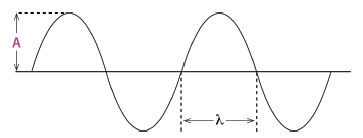
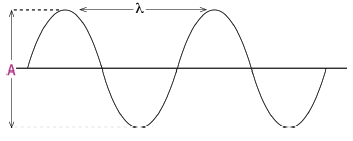
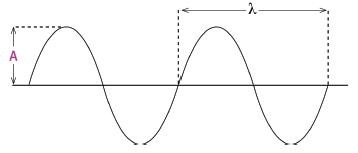
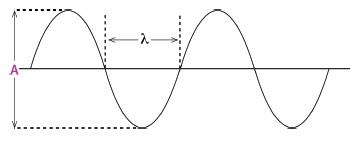 (3)
(3)